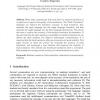Free Online Productivity Tools
i2Speak
i2Symbol
i2OCR
iTex2Img
iWeb2Print
iWeb2Shot
i2Type
iPdf2Split
iPdf2Merge
i2Bopomofo
i2Arabic
i2Style
i2Image
i2PDF
iLatex2Rtf
Sci2ools
HCI
2007
2007
Evaluation and Usability of Back Translation for Intercultural Communication
When users communicate with each other via machine translation, it is important to improve the quality of the translations. The “Back Translation” technique can improve the translation accuracy. A back translation, first, translates the input language into the target language (outward), and then translates the target language into the input language (homeward). This allows the users to confirm the accuracy of the machine translation by themselves. If the user finds that his input sentence is unsuitable for machine translator, he can rewrite the input sentence. For effective multilingual communication, it is important that the back translation offer good accuracy and good usability. This paper focuses on these two points; we evaluated the accuracy of back translation, and developed a user interface that improves the usability of back translation. The outward and homeward translations show a correlation. Back translation can improve the accuracy of outward translation for users.
| Added | 29 Oct 2010 |
| Updated | 29 Oct 2010 |
| Type | Conference |
| Year | 2007 |
| Where | HCI |
| Authors | Tomohiro Shigenobu |
Comments (0)

